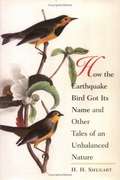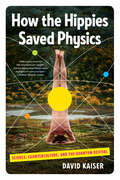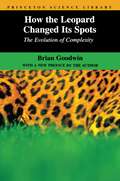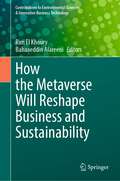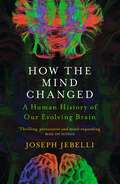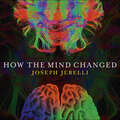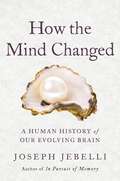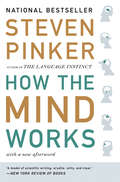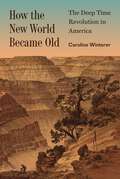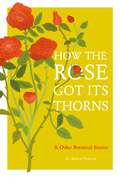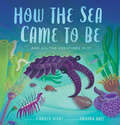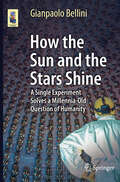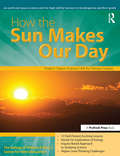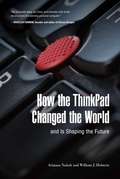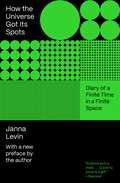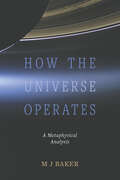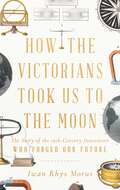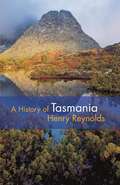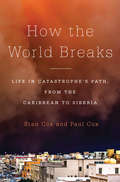- Table View
- List View
How the Earth Works: 60 Fun Activities for Exploring Volcanoes, Fossils, Earthquakes, and More
by Michelle O'Brien-PalmerEarth science comes alive for children 6 to 9 through 60 engrossing games, activities, and experiments. Kids “core sample” a filled cupcake and discover plate tectonics by floating graham cracker continents on a molten mantle of molasses. They learn how heat changes rocks by seeing how separate ingredients disappear when they bake Rice Krispie Treats. More activities show what causes earthquakes and what kinds of buildings resist their force. Growing sugar and salt crystals, “fossilizing” plastic insects, and modeling a variety of volcanoes add to the learning and the fun. Eight of the activities are tasty as well as informative. Silly songs help children remember new words and concepts, and a resource section gives inexpensive sources for rocks, minerals, and fossils. All the projects have been tested in homes and schools to make sure they are safe, effective, and fun.
How the Earthquake Bird Got Its Name: And Other Tales of an Unbalanced Nature
by H. H. ShugartAlthough people have been altering earth's landscapes to some extent for tens of thousands of years, humankind today is causing massive changes to the planet. Such widespread environmental change is accompanied by accelerating rates of species extinction. In this book, noted ecologist H. H. Shugart presents important ecological concepts through entertaining animal parables. He tells the stories of particular birds and mammals--the packrat, ivory-billed woodpecker, penguin, dingo, European rabbit, and others--and what their fates reveal about the interactions between environmental change and the extinctions or explosions of species populations. Change is the root of many planetary problems, but it is also an intrinsic feature of our living planet. Shugart explores past environmental change, discusses the non-existence of a "balance of Nature," and documents how human alterations have affected plants, soils, and animals. He looks with hope toward a future in which thoughtful people learn-and use-ecological science to protect the landscapes upon which terrestrial creatures depend.
How the Hippies Saved Physics: Science, Counterculture, and the Quantum Revival
by David Kaiser"Meticulously researched and unapologetically romantic, How the Hippies Saved Physics makes the history of science fun again."--Science In the 1970s, an eccentric group of physicists in Berkeley, California, banded together to explore the wilder side of science. Dubbing themselves the "Fundamental Fysiks Group," they pursued an audacious, speculative approach to physics, studying quantum entanglement in terms of Eastern mysticism and psychic mind reading. As David Kaiser reveals, these unlikely heroes spun modern physics in a new direction, forcing mainstream physicists to pay attention to the strange but exciting underpinnings of quantum theory.
How the Leopard Changed Its Spots: The Evolution of Complexity (Princeton Science Library #113)
by Brian GoodwinDo genes explain life? Can advances in evolutionary and molecular biology account for what we look like, how we behave, and why we die? In this powerful intervention into current biological thinking, Brian Goodwin argues that such genetic reductionism has important limits. Drawing on the sciences of complexity, the author shows how an understanding of the self-organizing patterns of networks is necessary for making sense of nature. Genes are important, but only as part of a process constrained by environment, physical laws, and the universal tendencies of complex adaptive systems. In a new preface for this edition, Goodwin reflects on the advances in both genetics and the sciences of complexity since the book's original publication.
How the Metaverse Will Reshape Business and Sustainability (Contributions to Environmental Sciences & Innovative Business Technology)
by Rim El Khoury Bahaaeddin AlareeniSustainability is part of every aspect of our life, with climate concerns shaping the future. Thus, it is important to understand how metaverse will affect sustainability, as it is opening both challenges and opportunities for environmental sustainability. On the one side, replacing real-world interactions with 3D virtual and exchanging physical goods with digital ones are significantly less resource-intensive and more carbon-efficient. Therefore, this holds the promise of reducing the environmental pollution. On the other side, metaverse increases e-waste and energy consumption. Given this controversial impact, it is crucial for businesses and researchers to understand how to ensure that the metaverse develops sustainably. This book is popping out several questions: Do businesses understand the metaverse concept and perceive the benefits and advantages of implementing such technologies? How will the metaverse change business? Will metaverse change our working place and skills needed? How can companies get ahead of the change and mold it to their advantage? Will businesses use metaverse? Can metaverse create a more sustainable word? How can we make the metaverse better than what we have now? Is it going to affect environmental sustainability? Will it cause more severe climate problems, or would it be the solution? How can metaverse impact the achievements of SDGs?
How the Mind Changed: A Human History of our Evolving Brain
by Joseph JebelliThe extraordinary story of how the human brain evolved... and is still evolving. We've come a long way. The earliest human had a brain as small as a child's fist; ours are four times bigger, with spectacular abilities and potential we are only just beginning to understand.This is How the Mind Changed, a seven-million-year journey through our own heads, packed with vivid stories, groundbreaking science, and thrilling surprises. Discover how memory has almost nothing to do with the past; meditation rewires our synapses; magic mushroom use might be responsible for our intelligence; climate accounts for linguistic diversity; and how autism teaches us hugely positive lessons about our past and future.Dr Joseph Jebelli's In Pursuit of Memory was shortlisted for the Royal Society Science Book Prize and longlisted for the Wellcome. In this, his eagerly awaited second book, he draws on deep insights from neuroscience, evolutionary biology, psychology, and philosophy to guide us through the unexpected changes that shaped our brains. From genetic accidents and environmental forces to historical and cultural advances, he explores how our brain's evolution turned us into Homo sapiens and beyond.A single mutation is all it takes.
How the Mind Changed: A Human History of our Evolving Brain
by Joseph JebelliThe extraordinary story of how the human brain evolved by Royal Society Prize shortlisted neuroscientist, Joseph Jebelli.No other life form on the planet has generated a brain like ours. How did a bundle of cells weighing just 1.2 kg give rise to conscious, self-aware beings capable of understanding time, language, mathematics and music, of exploring outer space and sequencing their own DNA? The answer to such questions is a 7 million year saga. How the Mind Changed is the definitive audiobook on human brain evolution: a sweeping natural history. Beginning with the first primate brain and the rise of our present-day, large human brain, it will describe the remarkable origin of our species' most mysterious organ, how it has developed, and how it will change in the future. To study the brain is to study the essence of what makes us human.(P) 2022 Hodder & Stoughton Limited
How the Mind Changed: A Human History of Our Evolving Brain
by Joseph JebelliThe extraordinary story of how the human brain evolved… and is still evolving. We&’ve come a long way. The earliest human had a brain as small as a child&’s fist; ours are four times bigger, with spectacular abilities and potential we are only just beginning to understand. This is How the Mind Changed, a seven-million-year journey through our own heads, packed with vivid stories, groundbreaking science, and thrilling surprises. Discover how memory has almost nothing to do with the past; meditation rewires our synapses; magic mushroom use might be responsible for our intelligence; climate accounts for linguistic diversity; and how autism teaches us hugely positive lessons about our past and future. Dr. Joseph Jebelli&’s In Pursuit of Memory was shortlisted for the Royal Society Science Book Prize and longlisted for the Wellcome. In this, his eagerly awaited second book, he draws on deep insights from neuroscience, evolutionary biology, psychology, and philosophy to guide us through the unexpected changes that shaped our brains. From genetic accidents and environmental forces to historical and cultural advances, he explores how our brain&’s evolution turned us into Homo sapiens and beyond. A single mutation is all it takes.
How the Mind Works
by Steven Pinker"A model of scientific writing: erudite, witty, and clear." --New York Review of Books In this Pulitzer Prize finalist and national bestseller, one of the world's leading cognitive scientists tackles the workings of the human mind. What makes us rational--and why are we so often irrational? How do we see in three dimensions? What makes us happy, afraid, angry, disgusted, or sexually aroused? Why do we fall in love? And how do we grapple with the imponderables of morality, religion, and consciousness? ?How the Mind Works? synthesizes the most satisfying explanations of our mental life from cognitive science, evolutionary biology, and other fields to explain what the mind is, how it evolved, and how it allows us to see, think, feel, laugh, interact, enjoy the arts, and contemplate the mysteries of life. This new edition of Pinker's bold and buoyant classic is updated with a new foreword by the author.
How the New World Became Old: The Deep Time Revolution in America (Princeton Modern Knowledge #1)
by Caroline WintererHow the idea of deep time transformed how Americans see their country and themselvesDuring the nineteenth century, Americans were shocked to learn that the land beneath their feet had once been stalked by terrifying beasts. T. rex and Brontosaurus ruled the continent. North America was home to saber-toothed cats and woolly mammoths, great herds of camels and hippos, and sultry tropical forests now fossilized into massive coal seams. How the New World Became Old tells the extraordinary story of how Americans discovered that the New World was not just old—it was a place rooted in deep time.In this panoramic book, Caroline Winterer traces the history of an idea that today lies at the heart of the nation&’s identity as a place of primordial natural beauty. Europeans called America the New World, and literal readings of the Bible suggested that Earth was only six thousand years old. Winterer takes readers from glacier-capped peaks in Yosemite to Alabama slave plantations and canal works in upstate New York, describing how naturalists, explorers, engineers, and ordinary Americans unearthed a past they never suspected, a history more ancient than anyone ever could have imagined.Drawing on archival evidence ranging from unpublished field notes and letters to early stratigraphic diagrams, How the New World Became Old reveals how the deep time revolution ushered in profound changes in science, literature, art, and religion, and how Americans came to realize that the New World might in fact be the oldest world of all.
How the Rose Got Its Thorns: And Other Botanical Stories
by Dr Andrew OrmerodHave you ever wondered why the rose has thorns and other flowers don't; why the daffodil is the colour it is; or why some plants have shiny leaves and others matt?How The Rose Got its Thorns reveals the inner workings of our favourite flowers and trees. Designed to help gardeners, both novice and experienced, better understand how plants grow, the book is easy to navigate - it is divided into 50 chapters, each one a story.Accompanied by specially commissioned colour illustrations, each chapter explains the science behind how plants work and the extraordinary processes they have evolved: such as protecting themselves from predators using chemicals; attracting pollinators using scent, shape and colour; growing in low or high temperatures; their relationship with the wind; the size and pattern of their leaves; the distribution of their seeds and survival strategies; their relationship with insects; how they allocate their resources; and how they retain water efficiently.This delightful and intriguing book offers readers an accessible way to better understand how our plants evolved into the species of today.
How the Rose Got Its Thorns: And Other Botanical Stories
by Dr Andrew OrmerodHave you ever wondered why the rose has thorns and other flowers don't; why the daffodil is the colour it is; or why some plants have shiny leaves and others matt?How The Rose Got its Thorns reveals the inner workings of our favourite flowers and trees. Designed to help gardeners, both novice and experienced, better understand how plants grow, the book is easy to navigate - it is divided into 50 chapters, each one a story.Accompanied by specially commissioned colour illustrations, each chapter explains the science behind how plants work and the extraordinary processes they have evolved: such as protecting themselves from predators using chemicals; attracting pollinators using scent, shape and colour; growing in low or high temperatures; their relationship with the wind; the size and pattern of their leaves; the distribution of their seeds and survival strategies; their relationship with insects; how they allocate their resources; and how they retain water efficiently.This delightful and intriguing book offers readers an accessible way to better understand how our plants evolved into the species of today.
How the Sea Came to Be: (And All the Creatures In It)
by Jennifer BerneA lyrical, spectacular history of the ocean—from its dramatic evolutionary past to its marvelously biodiverse present.&“For millions of years these first bits of lifeBecame more, and then more, and then more.&”Long, long ago, when the Earth was young and new, the world was a fiery place. Volcanoes exploded from deep down below, and steamy, hot clouds rose up high. Rain poured down for thousands of years, filling the world&’s very first oceans. There the teeniest stirrings of life began. Earth&’s creatures grew bigger and bigger, evolving into exciting forms like jellyfish, coral, and worms. Millions of years passed. Down in the depths and up on the surface, ocean life grew and spread. Now the sea teems with all kinds of animals—squid, turtles, dolphins, barracudas, even glowing fish, all living in the waters where long, long ago, life itself came to be. Spanning 4.5 billion years of evolution, this extensively researched book is an accessible introduction to geology, oceanography, and marine biology. Entrancing verse, awe-inspiring art, and fascinating back matter capture the mysterious beauty of the ocean and the incredible organisms who call it home.
How the Snake Lost its Legs: Curious Tales from the Frontier of Evo-Devo
by Lewis I. Held Jr.How did the zebra really get its stripes, and the giraffe its long neck? What is the science behind camel humps, leopard spots, and other animal oddities? Such questions have fascinated us for centuries, but the expanding field of evo-devo (evolutionary developmental biology) is now providing, for the first time, a wealth of insights and answers. Taking inspiration from Kipling's 'Just So Stories', this book weaves emerging insights from evo-devo into a narrative that provides startling explanations for the origin and evolution of traits across the animal kingdom. Held's unique and engaging style makes this narrative both enlightening and entertaining, guiding students and researchers through even complex concepts and encouraging a fuller understanding of the latest developments in the field. The first five chapters cover the first bilaterally symmetric animals, flies, butterflies, snakes, and cheetahs. A final chapter surveys recent results about a menagerie of other animals.
How the Sparrow Learned Its Song (Inheritance and Traits)
by Channon Jackson Ari Krakowski Ashley ChaseNIMAC-sourced textbook
How the Sun and the Stars Shine: A Single Experiment Solves a Millennia-Old Question of Humanity (Astronomers' Universe)
by Gianpaolo BelliniThis book presents the story of an experiment with historical significance that, for the first time, uncovered the mechanisms responsible for solar energy production and those generating energy in massive stars. The results were obtained by directly measuring the neutrino fluxes produced by individual fusion reactions in the Sun and providing the initial evidence of nuclear reactions occurring in massive stars via the CNO cycle. The CNO cycle is theorized to be the primary channel for hydrogen burning in stars more massive than the Sun and is, in fact, the primary channel for hydrogen burning in the Universe. These groundbreaking discoveries stem from a singular 32-year experiment, spanning from 1990 to 2021. The book commences with the experiment's genesis, placing it within the historical context of astrophysics and astroparticle physics. It then delves into the detector's conceptualization, gently describing the techniques used and addressing the challenges in constructing the detector. The narrative is presented in a simple and popular style, maintaining rigorous scientific adherence to the obtained results. The book is intended for a general audience not necessarily familiar with science, especially physics, but with a curiosity and interest in astrophysics. It aims to reach those who may be unaware of the complexities involved in conducting a scientific experiment, particularly one pushing the limits of feasibility. Additionally, it may appeal to those interested in amateur physics or astrophysics. The core novelty of the book lies in its detailed exploration of an experiment, encompassing scientific, cultural, personal, and even sociological dimensions.
How the Sun Makes Our Day: An Earth and Space Science Unit for High-Ability Learners in Grades K-1
by Clg Of William And Mary/Ctr Gift EdHow the Sun Makes Our Day, an Earth and space science unit for grades K-1, engages students in investigations and observations about the sun as a source of light and energy, the nature of shadows, man-made sources of energy, and the need for humans to conserve natural resources.How the Sun Makes Our Day was developed by the Center for Gifted Education at The College of William and Mary to offer advanced curriculum supported by years of research. The Center's materials have received national recognition from the United States Department of Education and the National Association for Gifted Children, and they are widely used both nationally and internationally.Each of the books in this series offers curriculum that focuses on advanced content and higher level processes. The science units contain simulations of real-world problems, and students experience the work of real science by using data-handling skills, analyzing information, and evaluating results. The mathematics units provide sophisticated ideas and concepts, challenging extensions, higher order thinking skills, and opportunities for student exploration based on interest. These materials are a must for any teacher seeking to challenge and engage learners and increase achievement.Grades K-1
How the ThinkPad Changed the World—and Is Shaping the Future
by Arimasa Naitoh William HolsteinThe ThinkPad notebook computer has been at the center of the digital revolution that has transformed millions of lives around the world, allowing users to obtain access to their documents, pictures and other personal data from virtually anywhere at any time. More than 100 million ThinkPads have been sold since they were introduced in 1992, some twenty-five years ago. ThinkPads played a prominent role in NASA's space exploration and at the International Space Station. They accompanied explorers who traversed the entire length of the Nile River and conquered Mount Everest. ThinkPads also played a major role in changing the very architecture of how humanity's knowledge is stored and made available.In this book, Arimasa Naitoh, the father of the ThinkPad, collaborates with American business journalist and author William J. Holstein to write candidly about the incredible technological and personal struggles he and fellow engineers faced. And he offers his vision of the future of mobile computing—because this revolution is not even close to being finished.
How the Universe Got Its Spots: Diary of A Finite Time in A Finite Space
by Janna LevinIs the universe infinite or just really big? With this question, the gifted young cosmologist Janna Levin not only announces the central theme of her intriguing and controversial new book but establishes herself as one of the most direct and unorthodox voices in contemporary science. For even as she sets out to determine how big "really big" may be, Levin gives us an intimate look at the day-to-day life of a globe-trotting physicist, complete with jet lag and romantic disturbances. Nimbly synthesizing geometry, topology, chaos and string theories, Levin shows how the pattern of hot and cold spots left over from the big bang may one day reveal the size and shape of the cosmos. She does so with such originality, lucidity--and even poetry--that How the Universe Got Its Spots becomes a thrilling and deeply personal communication between a scientist and the lay reader.
How the Universe Got Its Spots: Diary of a Finite Time in a Finite Space
by Janna LevinIs the universe infinite, or is it just really big? Does nature abhor infinity? In startling and beautiful prose, Janna Levin's diary of unsent letters to her mother describes what we know about the shape and extent of the universe, about its beginning and its end. She grants the uninitiated access to the astounding findings of contemporary theoretical physics and makes tangible the contours of space and time—those very real curves along which apples fall and planets orbit.Levin guides the reader through the observations and thought-experiments that have enabled physicists to begin charting the universe. She introduces the cosmic archaeology that makes sense of the pattern of hot spots left over from the big bang, a pursuit on the verge of discovering the shape of space itself. And she explains the topology and the geometry of the universe now coming into focus—a strange map of space full of black holes, chaotic flows, time warps, and invisible strings. Levin advances the controversial idea that this map is edgeless but finite—that the universe is huge but not unending—a radical revelation that would provide the ultimate twist to the Copernican revolution by locating our precise position in the cosmos.As she recounts our increasingly rewarding attempt to know the universe, Levin tells her personal story as a scientist isolated by her growing knowledge. This book is her remarkable effort to reach across the distance of that knowledge and share what she knows with family and friends—and with us. Highly personal and utterly original, this physicist’s diary is a breathtaking contemplation of our deep connection with the universe and our aspirations to comprehend it.
How the Universe Operates: A Metaphysical Analysis
by M J BakerWhy do the heavenly bodies behave in a contrary fashion to what we are familiar with on earth? Before a wheel can turn, we must ensure rim is joined to axle; before a couple can dance in circle, their hands must be joined. In contrast, the planets circle the sun and the moons circle the planets without any securing mechanism, and so precisely that their movements can be predicted to a millisecond. Again, why is it that, released from the effects of gravity, emollient matter like water or molten lead forms spontaneously into tiny globes, copying the form found in stars, planets and the sun? Are the tides satisfactorily explained by the thesis of gravitational ‘pull’ of moon and sun? If so, why does modern science have such difficulty reconciling the relative influences of these two bodies? What sort of reality is light, and why is the speed of light fixed and not infinite, at least in space? Answers to these and other questions may be found through recourse to the philosophy of Aristotle. The thinkers of the Enlightenment chose to discard Aristotle’s limited natural science. That was understandable. But they chose to discard his philosophy as well. This was unwise, as fresh study of Aristotle’s thinking will show.
How the Vertebrate Brain Regulates Behavior: Direct from the Lab
by Donald PfaffThroughout his career, Donald Pfaff has demonstrated that by choosing problems and methods with care, biologists can study the molecular mechanisms of brains more complex than those of fruit flies, snails, and roundworms. He offers a close-up, conversational perspective on a 50-year quest to understand how behavior is regulated in vertebrates.
How the Victorians Took Us to the Moon: The Story of the 19th-Century Innovators Who Forged Our Future
by Iwan Rhys MorusThe rich and fascinating history of the scientific revolution of the Victorian Era, leading to transformative advances in the twentieth and twenty-first centuries.The Victorians invented the idea of the future. They saw it as an undiscovered country, one ripe for exploration and colonization. And to get us there, they created a new way of ordering and transforming nature, built on grand designs and the mass-mobilization of the resources of the British Empire. With their expert culture of accuracy and precision, they created telegraphs and telephones, electric trams and railways, built machines that could think, and devised engines that could reach for the skies. When Cyrus Field&’s audacious plan to lay a telegraph cable across the Atlantic finally succeeded in 1866, it showed how science, properly disciplined, could make new worlds. As crowds flocked to the Great Exhibition of 1851 and the exhibitions its success inaugurated, they came to see the future made fact—to see the future being built before their eyes. In this rich and absorbing book, a distinguished historian of science tells the story of how this future was made. From Charles Babbage&’s dream of mechanizing mathematics to Isambard Kingdom Brunel&’s tunnel beneath the Thames to George&’s Cayley&’s fantasies of powered flight and Nikola Tesla&’s visions of an electrical world, it is a story of towering personalities, clashing ambitions, furious rivalries and conflicting cultures—a rich tapestry of remarkable lives that transformed the world beyond recognition and ultimately took mankind to the Moon
How the Weak Win Wars: A Theory of Asymmetric Conflict
by Ivan Arreguín-ToftHow do the weak defeat the strong? Ivan Arreguín-Toft argues that, although many factors affect asymmetric conflict outcomes (for example, the relative power of the actors, their weapons technology, and outside support), the interaction of each actor's strategy is the best explanation. Supporting his argument with combined statistical and comparative case study analysis, Arreguín-Toft's strategic interaction theory has implications not only for international relations theorists, but for policy makers grappling with interstate and civil wars, as well as terrorism.
How the World Breaks: Life in Catastrophe's Path, from the Caribbean to Siberia
by Stan Cox Paul CoxWe've always lived on a dangerous planet, but its disasters aren't what they used to be. How the World Breaks gives us a breathtaking new view of crisis and recovery on the unstable landscapes of the Earth's hazard zones. Father and son authors Stan and Paul Cox take us to the explosive fire fronts of overheated Australia, the future lost city of Miami, the fights over whether and how to fortify New York City in the wake of Sandy, the Indonesian mud volcano triggered by natural gas drilling, and other communities that are reimagining their lives after quakes, superstorms, tornadoes, and landslides.In the very decade when we should be rushing to heal the atmosphere and address the enormous inequalities of risk, a strange idea has taken hold of global disaster policy: resilience. Its proponents say that threatened communities must simply learn the art of resilience, adapt to risk, and thereby survive. This doctrine obscures the human hand in creating disasters and requires the planet's most beleaguered people to absorb the rush of floodwaters and the crush of landslides, freeing the world economy to go on undisturbed. The Coxes' great contribution is to pull the disaster debate out of the realm of theory and into the muck and ash of the world's broken places. There we learn that change is more than mere adaptation and life is more than mere survival. Ultimately, How the World Breaks reveals why--unless we address the social, ecological, and economic roots of disaster--millions more people every year will find themselves spiraling into misery. It is essential reading for our time.

